2009 Seat Ibiza ST warning light
[x] Cancel search: warning lightPage 4 of 250

Contents3
ContentsManual structure
. . . . . . . . . . . . . . . . . . . .
Content
. . . . . . . . . . . . . . . . . . . . . . . . . . . . . . . .
Safety First
. . . . . . . . . . . . . . . . . . . . . . . . . . .
Safe driving
. . . . . . . . . . . . . . . . . . . . . . . . . . . . . .
Brief introduction . . . . . . . . . . . . . . . . . . . . . . . .
Proper sitting position for occupants . . . . . . . . .
Pedal area . . . . . . . . . . . . . . . . . . . . . . . . . . . . . .
Stowing luggage . . . . . . . . . . . . . . . . . . . . . . . . .
Seat belts
. . . . . . . . . . . . . . . . . . . . . . . . . . . . . . . .
Brief introduction . . . . . . . . . . . . . . . . . . . . . . . .
Why wear seat belts? . . . . . . . . . . . . . . . . . . . . . .
Seat belts . . . . . . . . . . . . . . . . . . . . . . . . . . . . . . .
Belt tensioners* . . . . . . . . . . . . . . . . . . . . . . . . . .
Airbag system
. . . . . . . . . . . . . . . . . . . . . . . . . . . .
Brief introduction . . . . . . . . . . . . . . . . . . . . . . . .
Front airbags . . . . . . . . . . . . . . . . . . . . . . . . . . . .
Side airbags . . . . . . . . . . . . . . . . . . . . . . . . . . . . .
Deactivating airbags* . . . . . . . . . . . . . . . . . . . . .
Child safety
. . . . . . . . . . . . . . . . . . . . . . . . . . . . . .
Brief introduction . . . . . . . . . . . . . . . . . . . . . . . .
Child seats . . . . . . . . . . . . . . . . . . . . . . . . . . . . . .
Securing child seats . . . . . . . . . . . . . . . . . . . . . .
Operating instructions
. . . . . . . . . . . .
Cockpit
. . . . . . . . . . . . . . . . . . . . . . . . . . . . . . . . . . .
Overview . . . . . . . . . . . . . . . . . . . . . . . . . . . . . . .
Instruments . . . . . . . . . . . . . . . . . . . . . . . . . . . . . Digital instrument panel display . . . . . . . . . . . .
Warning lamps . . . . . . . . . . . . . . . . . . . . . . . . . . .
Steering column controls*
. . . . . . . . . . . . . . . .
General notes . . . . . . . . . . . . . . . . . . . . . . . . . . .
Audio Control . . . . . . . . . . . . . . . . . . . . . . . . . . . .
Audio + Telephone Control . . . . . . . . . . . . . . . . .
Unlocking and locking
. . . . . . . . . . . . . . . . . . . .
Central locking . . . . . . . . . . . . . . . . . . . . . . . . . . .
Keys . . . . . . . . . . . . . . . . . . . . . . . . . . . . . . . . . . .
Radio frequency remote control* . . . . . . . . . . . .
Anti-theft alarm system* . . . . . . . . . . . . . . . . . . .
Rear lid . . . . . . . . . . . . . . . . . . . . . . . . . . . . . . . . .
Windows . . . . . . . . . . . . . . . . . . . . . . . . . . . . . . .
Panorama tilting roof* . . . . . . . . . . . . . . . . . . . . .
Lights and visibility
. . . . . . . . . . . . . . . . . . . . . . .
Lights . . . . . . . . . . . . . . . . . . . . . . . . . . . . . . . . . .
Interior lights . . . . . . . . . . . . . . . . . . . . . . . . . . . .
Visibility . . . . . . . . . . . . . . . . . . . . . . . . . . . . . . . .
Windscreen washers . . . . . . . . . . . . . . . . . . . . . .
Rear vision mirrors . . . . . . . . . . . . . . . . . . . . . . . .
Seats and storage compartments
. . . . . . . . . .
The importance of correct seat adjustment . . . .
Head restraints . . . . . . . . . . . . . . . . . . . . . . . . . .
Front seats . . . . . . . . . . . . . . . . . . . . . . . . . . . . . .
Rear seat bench . . . . . . . . . . . . . . . . . . . . . . . . . .
Storage compartment . . . . . . . . . . . . . . . . . . . . .
Ashtrays, cigarette lighter and power point . . .
First-aid kit, warning triangle, fire extinguisher
Luggage compartment . . . . . . . . . . . . . . . . . . . .
Roof carrier* . . . . . . . . . . . . . . . . . . . . . . . . . . . . .
Air conditioning
. . . . . . . . . . . . . . . . . . . . . . . . . .
Heating . . . . . . . . . . . . . . . . . . . . . . . . . . . . . . . . .
Air conditioning* . . . . . . . . . . . . . . . . . . . . . . . . .
Climatronic . . . . . . . . . . . . . . . . . . . . . . . . . . . . . .
General notes . . . . . . . . . . . . . . . . . . . . . . . . . . .
Driving
. . . . . . . . . . . . . . . . . . . . . . . . . . . . . . . . . . .
Address . . . . . . . . . . . . . . . . . . . . . . . . . . . . . . . .
Safety . . . . . . . . . . . . . . . . . . . . . . . . . . . . . . . . . .
Ignition lock . . . . . . . . . . . . . . . . . . . . . . . . . . . . .
Starting and stopping the engine . . . . . . . . . . .
Manual gearbox . . . . . . . . . . . . . . . . . . . . . . . . . .
Automatic gearbox* . . . . . . . . . . . . . . . . . . . . . .
Handbrake . . . . . . . . . . . . . . . . . . . . . . . . . . . . . .
Acoustic parking aid system* . . . . . . . . . . . . . . .
Cruise control* (GRA) . . . . . . . . . . . . . . . . . . . . .
Practical tips
. . . . . . . . . . . . . . . . . . . . . . . . .
Intelligent technology
. . . . . . . . . . . . . . . . . . . . .
Brakes . . . . . . . . . . . . . . . . . . . . . . . . . . . . . . . . .
Anti-lock brake system and traction control ABS
Electronic Stability Programme (ESP)* . . . . . . . .
Driving and the environment
. . . . . . . . . . . . . .
Running-in . . . . . . . . . . . . . . . . . . . . . . . . . . . . . .
Exhaust gas purification system . . . . . . . . . . . . .
Economical and environmentally-friendly driving
Driving abroad . . . . . . . . . . . . . . . . . . . . . . . . . . .
Trailer towing . . . . . . . . . . . . . . . . . . . . . . . . . . . .
Vehicle maintenance and cleaning
. . . . . . . .
General notes . . . . . . . . . . . . . . . . . . . . . . . . . . .
Care of the vehicle exterior . . . . . . . . . . . . . . . . .
Vehicle interior maintenance . . . . . . . . . . . . . . .
5
6
7
7
7
9
14
15
17
17
18
21
25
26
26
29
32
36
38
38
40
43
47
47
47
49 50
56
66
66
67
68
70
70
75
76
78
80
82
85
87
87
93
94
95
98
101
101
102
104
106
107
111
114
115
118 120
120
123
126
129
130
130
131
132
133
135
136
143
145
147
151
151
151
152
153
156
156
157
158
160
160
163
163
164
170
Ibiza ST_EN.book Seite 3 Dienstag, 12. Januar 2010 4:03 16
Page 9 of 250

Safe driving
8Therefore, information is provided about why this equipment is so important,
h o w i t p r o t e c t s yo u , w h a t yo u ha v e to co n s i d e r w h e n u s i n g i t a n d h o w yo u a n d
your passengers can achieve the greatest possible benefit from the safety
equipment fitted. This manual includes important warnings that you and your
passengers should note in order to reduce the risk of injury.
Safety is everyone's business!Before every trip
The driver bears the responsibility for his passengers and the
operational worthiness of the vehicle.For your own safety and the safety of your passengers, always note
the following points before every trip:
– Ensure that the vehicle's lights and turn signals operate flaw-
lessly.
– Check tyre pressure.
– Ensure that all windows provide a clear and good view of the surroundings.
– Secure all baggage ⇒page 15.
– Make sure that no objects can interfere with the pedals.
– Adjust front seat, head restraint and mirrors properly according to your size.
– Ensure that the passenger in the central rear seat always has the head restraint in the co rrect position for use. – Instruct passengers to adjust the head restraints according to
their height.
– Protect children with appropriate child seats and properly applied seat belts ⇒page 38.
– Assume the correct sitting position. Instruct your passengers also to assume a proper sitting position ⇒page 9.
– Fasten your seat belt securely. Instruct your passengers also to fasten their seat belts properly ⇒ page 17.
What affects driving safety?
Driving safety is largely determined by your driving style and
the personal behaviour of all occupants.As a driver, you are responsible for yourself and your passengers.
When your concentration or driving safety is affected by any circum-
stance, you endanger yourself as well as others on the road ⇒,
for this reason:
– Do not allow yourself to be distracted from the traffic around you, e.g. by passengers or telephone conversations.
– Never drive when your driving abil ity is impaired (e.g. by medica-
tion, alcohol, drugs).
– Observe traffic laws and speed limits.
– Always reduce your speed as appropriate for road, traffic and weather conditions.
Ibiza ST_EN.book Seite 8 Dienstag, 12. Januar 2010 4:03 16
Page 10 of 250
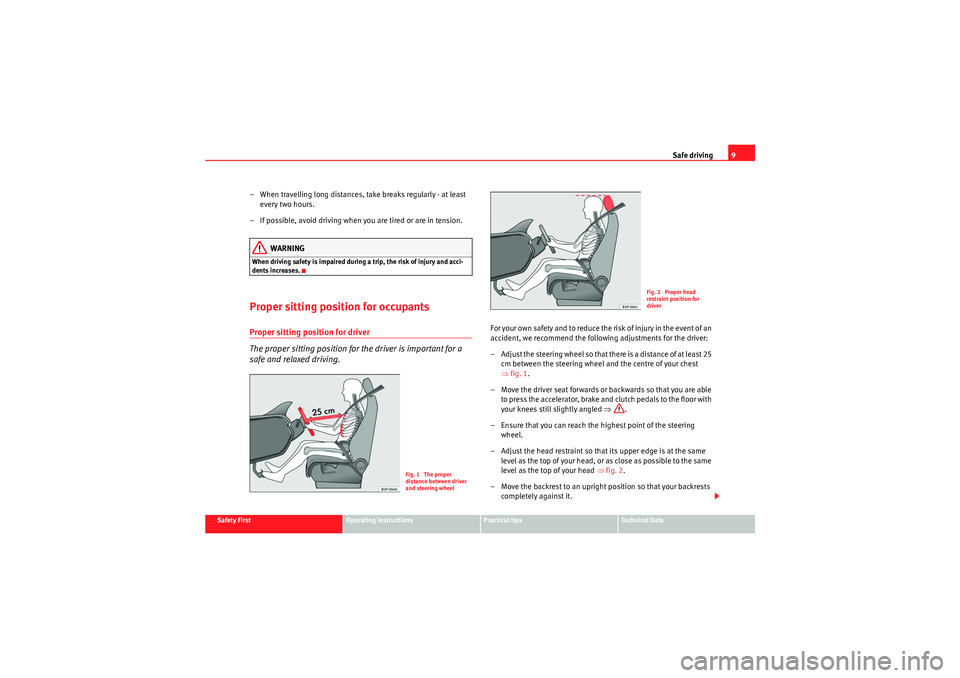
Safe driving9
Safety First
Operating instructions
Practical tips
Technical Data
– When travelling long distances, take breaks regularly - at least
every two hours.
– If possible, avoid driving when you are tired or are in tension.
WARNING
When driving safety is impaired during a trip, the risk of injury and acci-
dents increases.Proper sitting position for occupantsProper sitting position for driver
The proper sitting position for the driver is important for a
safe and relaxed driving.
For your own safety and to reduce the risk of injury in the event of an
accident, we recommend the following adjustments for the driver:
– Adjust the steering wheel so that there is a distance of at least 25 cm between the steering wheel and the centre of your chest
⇒fig. 1 .
– Move the driver seat forwards or backwards so that you are able to press the accelerator, brake and clutch pedals to the floor with
your knees still slightly angled ⇒.
– Ensure that you can reach the highest point of the steering wheel.
– Adjust the head restraint so that its upper edge is at the same level as the top of your head, or as close as possible to the same
level as the top of your head ⇒ fig. 2.
– Move the backrest to an upright position so that your backrests completely against it.
Fig. 1 The proper
distance between driver
and steering wheel
Fig. 2 Proper head
restraint position for
driver
Ibiza ST_EN.book Seite 9 Dienstag, 12. Januar 2010 4:03 16
Page 17 of 250
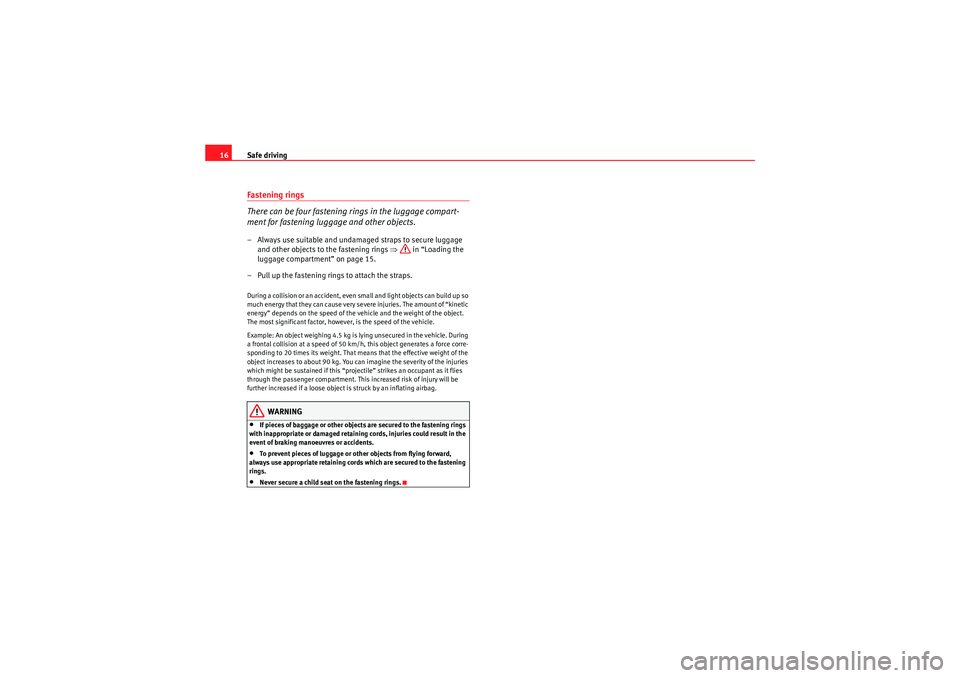
Safe driving
16Fastening rings
There can be four fastening rings in the luggage compart-
ment for fastening luggage and other objects.– Always use suitable and undamaged straps to secure luggage
and other objects to the fastening rings ⇒ in “Loading the
luggage compartment” on page 15.
– Pull up the fastening rings to attach the straps.During a collision or an accident, even small and light objects can build up so
much energy that they can cause very severe injuries. The amount of “kinetic
energy” depends on the speed of the vehicle and the weight of the object.
The most significant factor, however, is the speed of the vehicle.
Example: An object weighing 4.5 kg is lying unsecured in the vehicle. During
a frontal collision at a speed of 50 km/h, this object generates a force corre-
sponding to 20 times its weight. That means that the effective weight of the
object increases to about 90 kg. You can imagine the severity of the injuries
which might be sustained if this “projectile” strikes an occupant as it flies
through the passenger compartment. This increased risk of injury will be
further increased if a loose object is struck by an inflating airbag.
WARNING
•If pieces of baggage or other objects are secured to the fastening rings
with inappropriate or damaged retaining cords, injuries could result in the
event of braking manoeuvres or accidents.•To prevent pieces of luggage or other objects from flying forward,
always use appropriate retaining cords which are secured to the fastening
rings.•Never secure a child seat on the fastening rings.
Ibiza ST_EN.book Seite 16 Dienstag, 12. Januar 2010 4:03 16
Page 19 of 250
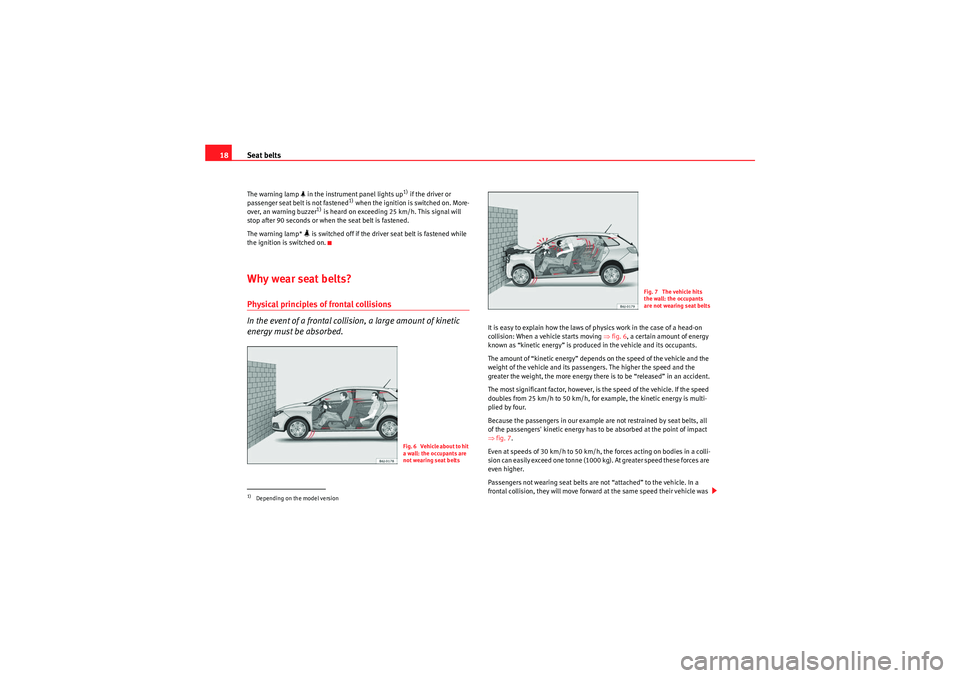
Seat belts
18The warning lamp in the instrument panel lights up
1) if the driver or
passenger seat belt is not fastened
1) when the ignition is switched on. More-
over, an warning buzzer
1) is heard on exceeding 25 km/h. This signal will
stop after 90 seconds or when the seat belt is fastened.
The warning lamp*
is switched off if the driver seat belt is fastened while
the ignition is switched on.
Why wear seat belts?Physical principles of frontal collisions
In the event of a frontal collision, a large amount of kinetic
energy must be absorbed.
It is easy to explain how the laws of physics work in the case of a head-on
collision: When a vehicle starts moving ⇒fig. 6, a certain amount of energy
known as “kinetic energy” is produced in the vehicle and its occupants.
The amount of “kinetic energy” depends on the speed of the vehicle and the
weight of the vehicle and its passengers. The higher the speed and the
greater the weight, the more energy there is to be “released” in an accident.
The most significant factor, however, is the speed of the vehicle. If the speed
doubles from 25 km/h to 50 km/h, for example, the kinetic energy is multi-
plied by four.
Because the passengers in our example are not restrained by seat belts, all
of the passengers' kinetic energy has to be absorbed at the point of impact
⇒ fig. 7.
Even at speeds of 30 km/h to 50 km/h, the forces acting on bodies in a colli-
sion can easily exceed one tonne (1000 kg). At greater speed these forces are
even higher.
Passengers not wearing seat belts are not “attached” to the vehicle. In a
frontal collision, they will move forward at the same speed their vehicle was
1)Depending on the model version
Fig. 6 Vehicle about to hit
a wall: the occupants are
not wearing seat belts
Fig. 7 The vehicle hits
the wall: the occupants
are not wearing seat belts
Ibiza ST_EN.book Seite 18 Dienstag, 12. Januar 2010 4:03 16
Page 26 of 250

Seat belts25
Safety First
Operating instructions
Practical tips
Technical Data
Belt tensioners*Function of the belt tension device
During a frontal collision, the seat belts on the front seats are
retracted automatically.The seat belts for the front occupants are equipped with belt tensioners.
Sensors will trigger the belt tensioners during severe head-on, lateral and
rear collisions only if the seat belt is being worn. This retracts and tightens the
seat belts, reducing the forward motion of the occupants.
The belt tension device can be triggered only once.
The belt tensioners will not be triggered in the event of light frontal and side
collisions, if the vehicle overturns, or in situations where no large forces act
on the front, side or rear of the vehicle.
Note
•If the belt tensioners are triggered, a fine dust is produced. This is normal
and it is not an indication of fire in the vehicle.•The relevant safety requirements must be observed when the vehicle or
components of the system are scrapped. A qualified workshop is familiar with
these regulations and will be pleased to pass on the information to you.Service and disposal of belt tensionersThe belt tensioners are components of the seat belts that are installed in the
seats of your vehicle. If you work on the belt tensioners or remove and install
parts of the system when performing other repair work, the seat belt may be
damaged. The consequence may be that, in the event of an accident, the belt
tensioners function incorrectly or not at all. So that the effectiveness of the belt tension device is not reduced and that
removed parts do not cause any injuries or environmental pollution, regula-
tions, which are known to the qualified workshops, must be observed.
WARNING
•If repairs are not carried out by a professional, or if the belt tensioners
are used incorrectly, the risk of severe or fatal injuries increases. The belt
tensioners may fail to trigger or may trigger in the wrong circumstances.•Never attempt to repair, adjust, remove or install parts of the belt
tensioners or seat belts.•The belt tension device and seat belt including its automatic retractor
cannot be repaired.•Any work on the belt tensioners and seat belts, including the removal
and refitting of system parts in conjunction with other repair work, must be
performed by a qualified workshop only.•The belt tensioners will only provide protection for one accident and
must be changed it they have been activated.
Ibiza ST_EN.book Seite 25 Dienstag, 12. Januar 2010 4:03 16
Page 29 of 250
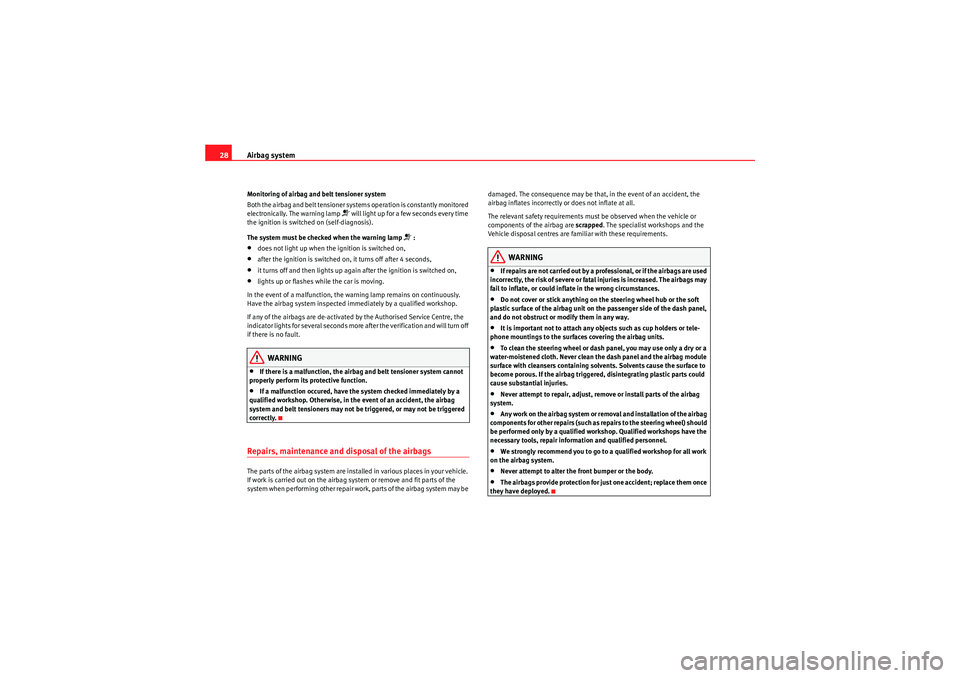
Airbag system
28Monitoring of airbag and belt tensioner system
Both the airbag and belt tensioner systems operation is constantly monitored
electronically. The warning lamp
will light up for a few seconds every time
the ignition is switched on (self-diagnosis).
The system must be checked when the warning lamp
:
•does not light up when the ignition is switched on,•after the ignition is switched on, it turns off after 4 seconds,•it turns off and then lights up again after the ignition is switched on,•lights up or flashes while the car is moving.
In the event of a malfunction, the warning lamp remains on continuously.
Have the airbag system inspected immediately by a qualified workshop.
If any of the airbags are de-activated by the Authorised Service Centre, the
indicator lights for several seconds more after the verification and will turn off
if there is no fault.WARNING
•If there is a malfunction, the airbag and belt tensioner system cannot
properly perform its protective function.•If a malfunction occured, have the system checked immediately by a
qualified workshop. Otherwise, in th e event of an accident, the airbag
system and belt tensioners may not be triggered, or may not be triggered
correctly.
Repairs, maintenance and disposal of the airbagsThe parts of the airbag system are installed in various places in your vehicle.
If work is carried out on the airbag system or remove and fit parts of the
system when performing other repair work, parts of the airbag system may be damaged. The consequence may be that, in the event of an accident, the
airbag inflates incorrectly or does not inflate at all.
The relevant safety requirements must be observed when the vehicle or
components of the airbag are
scrapped. The specialist workshops and the
Vehicle disposal centres are familiar with these requirements.
WARNING
•If repairs are not carried out by a professional, or if the airbags are used
incorrectl y, the ris k of severe or fatal inju ries is increase d. T he airbags may
fail to inflate, or could inflate in the wrong circumstances.•Do not cover or stick anything on the steering wheel hub or the soft
plastic surface of the airbag unit on the passenger side of the dash panel,
and do not obstruct or modify them in any way.•It is important not to attach any objects such as cup holders or tele-
phone mountings to the surfaces covering the airbag units.•To clean the steering wheel or dash panel, you may use only a dry or a
water-moistened cloth. Never clean the dash panel and the airbag module
surface with cleansers containing solvents. Solvents cause the surface to
become porous. If the airbag triggered, disintegrating plastic parts could
cause substantial injuries.•Never attempt to repair, adjust, remove or install parts of the airbag
system.•Any work on the airbag system or removal and installation of the airbag
components for other repairs (such as repairs to the steering wheel) should
be performed only by a qualified wo rkshop. Qualified workshops have the
necessary tools, repair inform ation and qualified personnel.•We strongly recommend you to go to a qualified workshop for all work
on the airbag system.•Never attempt to alter the front bumper or the body.•The airbags provide protection for just one accident; replace them once
they have deployed.
Ibiza ST_EN.book Seite 28 Dienstag, 12. Januar 2010 4:03 16
Page 30 of 250
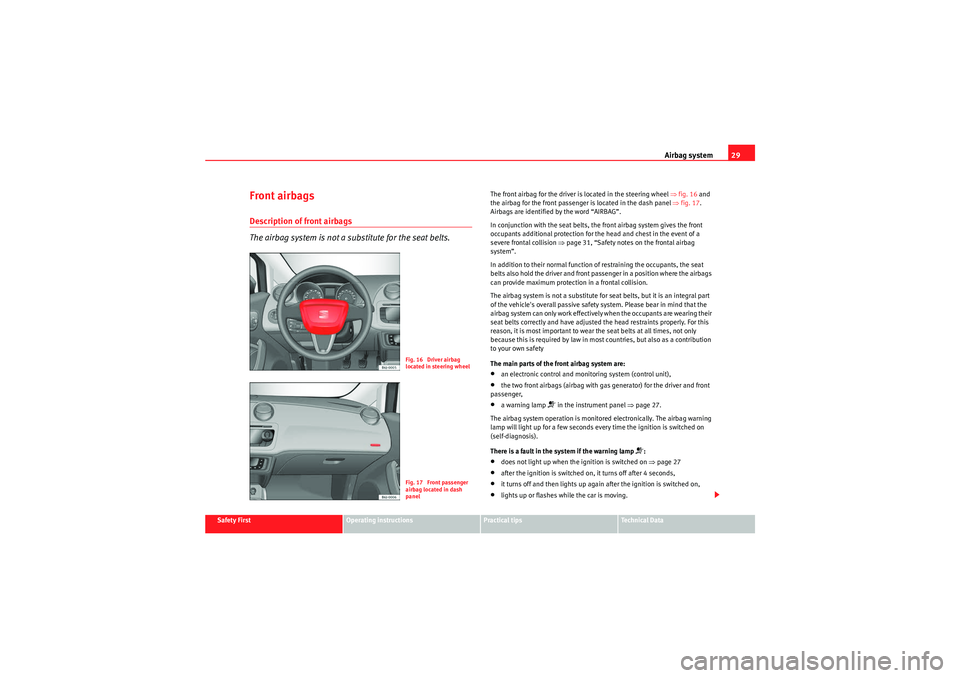
Airbag system29
Safety First
Operating instructions
Practical tips
Technical Data
Front airbagsDescription of front airbags
The airbag system is not a substitute for the seat belts.
The front airbag for the driver is located in the steering wheel ⇒fig. 16 and
the airbag for the front passenger is located in the dash panel ⇒fig. 17 .
Airbags are identified by the word “AIRBAG”.
In conjunction with the seat belts, the front airbag system gives the front
occupants additional protection for the head and chest in the event of a
severe frontal collision ⇒page 31, “Safety notes on the frontal airbag
system”.
In addition to their normal function of restraining the occupants, the seat
belts also hold the driver and front passenger in a position where the airbags
can provide maximum protection in a frontal collision.
The airbag system is not a substitute for seat belts, but it is an integral part
of the vehicle's overall passive safety system. Please bear in mind that the
airbag system can only work effectively when the occupants are wearing their
seat belts correctly and have adjusted the head restraints properly. For this
reason, it is most important to wear the seat belts at all times, not only
because this is required by law in most countries, but also as a contribution
to your own safety
The main parts of the front airbag system are:•an electronic control and monitoring system (control unit),•the two front airbags (airbag with gas generator) for the driver and front
passenger,•a warning lamp
in the instrument panel ⇒page 27.
The airbag system operation is monitored electronically. The airbag warning
lamp will light up for a few seconds every time the ignition is switched on
(self-diagnosis).
There is a fault in the system if the warning lamp
:
•does not light up when the ignition is switched on ⇒ page 27•after the ignition is switched on, it turns off after 4 seconds,•it turns off and then lights up again after the ignition is switched on,•lights up or flashes while the car is moving.
Fig. 16 Driver airbag
located in steering wheelFig. 17 Front passenger
airbag located in dash
panel
Ibiza ST_EN.book Seite 29 Dienstag, 12. Januar 2010 4:03 16